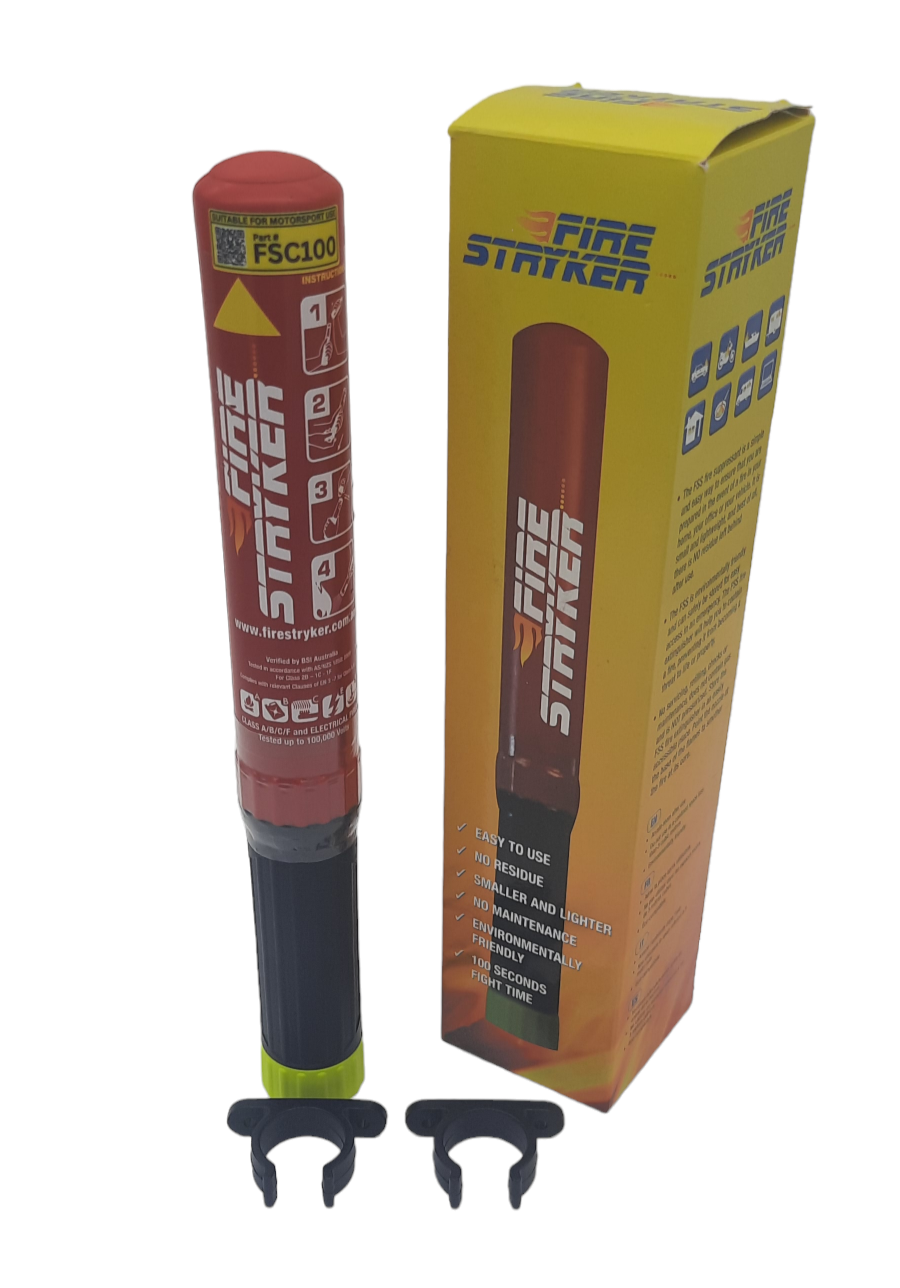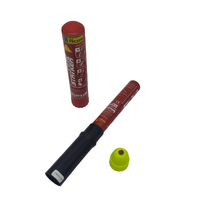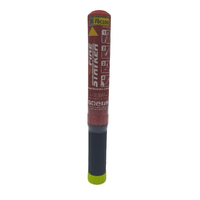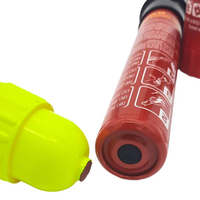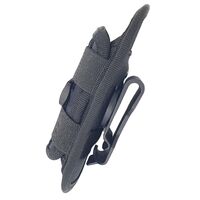Firestryker 100-Second Extinguisher Stick - Hand Held
May not fit your vehicle
Fits your vehicle
The worlds lightest and most effective fire extinguisher
SKU code: FSC100
The Firestryker FSC100 is a highly effective handheld fire extinguisher system. This small and compact unit is ideal to carry in your race, rally or classic motor car, motorhome, caravan, boat, or at home and delivers an incredibly effective way to extinguish fire very quickly and easily.
The remarkable Firestryker works on all types of fire and is totally non-toxic and environmentally friendly, and is so easy to use. It really is an absolute must to carry to save your cherished property from the devastation that fire can cause.
With a very fast but secure activation, it not only extinguishes fire effectively but leaves next to no residue or dusty mess to clean up afterwards, and nothing like the corrosive mess left behind like a dry powder or foam extinguisher. Being handheld the Firestryker can be directed onto the immediate location of the fire, concentrating the fire-eating properties exactly where it is needed.
Unlike traditional bottle fire extinguisher systems that require regular servicing, the Firestryker does not, and has a 10 year proven shelf life (8 for competition vehicles) and comes with a manufacturer 3-year warranty.
SPECIFICATION
- Emission Time - 100 Seconds
- Length - 32.8 cm
- Diameter - 3.3 cm
- Weight - 365 grams
- Includes 2 clamps
BENEFITS
- No Mess - Residue - Damage
- Works on all major fire types
- Lasts longer to fight fire
- Safe and Easy to use
- Non-toxic & environmentally safe / friendly
- No Maintenance required
- Small & Lightweight

The FSS is capable of extinguishing all types of fires in different classes,
- Class A: Solid material, ordinary combustibles such as wood, paper, fabric, plastics etc.
- Class B: Flammable liquids such as petrol, oil based paints, solvents, alcohol, acetone etc.
- Class C: Gaseous category, GLP, methane, acetylene etc.
- Class E: Electrical equipment fires subject to voltages up to 100.000V at a distance of 1m
- Class F: Cooking oil and fats
HOW DOES THE FIRESTRYKER WORK?
The Firestryker is a manual, portable fire extinguishing device. It uses a potassium powder jet (a unique method among conventional fire extinguishers) that employs the vaporisation of the powder in the environment followed by the condensation of its extinguishing substance. It works by interrupting a fire's chain of reaction (the "auto-catalyst" of the fire), effectively extinguishing a fire without making any mess or removing surrounding oxygen.
It is composed of stable, solid minerals; it does not contain gas and is not pressurised. The aerosol-like jet is only produced when the charger is struck with its base. The produced aerosol jet is free of thrust and is essentially an inert salt that emits gas already present in the atmosphere.
THE CHEMISTRY BEHIND IT
This process allows the Firestryker to extinguish all types of fires through saturation. It's slow bio-degradation in the environment furthers the prevention of subsequent fires / re-flash.
The extinguishing process involves two different reactions: one is physical and the other, chemical.
The physical reaction relates to potassium’s tendency to oxidise rapidly in air. When in contact with air, alkaline salts consume great quantities of oxygen, thus depriving fires of oxygen.
The chemical reaction is created through the stable link between potassium particles and the fire’s combustion particles.
Through the two reactions, a quick oxidation process takes place, immediately transforming the jet from a solid state into a gaseous state freeing the potassium particles. These atoms are able to intercept and interrupt any other free particles produced by the fire’s natural chain reaction combustion process.
Potassium has strong inhibitor qualities due to its weak ionisation energies. The extinguishing agent being used is composed of Potassium Nitrate, organic oxidiser and plasticisers resin.
When Potassium Nitrate (KNO3) discharges from the extinguisher it vaporises in the environment followed by the condensation of its extinguishing substance. When it reacts, it brakes down and the gas that is formed is made up primarily of free radicals of Potassium K+, of Nitrogen N (an inert gas) and water vapor.
The aerosol that comes out of the unit reacts with the fire. Potassium radicals (K+) attaches itself to the oxygen surrounding the fire robbing its ability to stick to the chain of combustion thereby extinguishing it and preventing a re-flash and all the time not affecting ones ability to breath that oxygen.
A simply illustration of the chemical reaction,

Stage 1 : Fire is initiated by the flame chain carriers: O, H and OH
Stage 2 : The Firestryker aerosol-like jet introduces Potassium radicals (K) into the flame chain
Stage 3 : K radicals attach themselves to O, H and OH and remove them from the flame reaction without depleting surrounding oxygen
Whats the best way to tackle a fire with it?
Unlike a dry chemical extinguisher that combats a blaze by depositing a large amount of solid powder on the fire, the Firestryker fights a fire by releasing a gas. This gas attaches itself to the oxygen surrounding the fire robbing its ability to stick to the chain of combustion (without affecting ones ability to breath that oxygen). The goal is therefore to use the gas coming out the FSC100 to create a ‘cloud of containment’ around a fire. Creating a cloud that prevents any outside and un-attached oxygen from getting to the fire is essential and is the same strategy that should also be used with a Halon/Halotron or CO2 extinguisher.
The two worst things you can do when fighting a fire with a gas extinguisher is to be too close or to rush the process. Being very close to a fire means that a cloud cannot be formed blocking any new oxygen that will continue to feed the flame. This is particularly problematic in an isolated pan situation where being too close will only chase the flames around. Rushing the process by moving the extinguisher around a lot also prevents a cloud from being formed and diminishes the performance of the extinguisher.
The best technique is to take advantage of the long discharge time offered by the Firestryker and to approach a fire from a moderate distance progressively getting closer to its source. During the approach, move the FSC100 slowly around the fire always directing towards the centre. This will contain the fire and allow the gas the ability to work.
Tight areas with lots of pockets (like the engine bay of a car for example) brings out the strengths of the FSC100 as the gas, which is heavier than air, will fill all the voids not directly accessible; both putting out a fire and preventing a re-flash.
- universal
| SKU | FSC100 |
| Brand | Firestryker |
| Shipping Weight | 0.5000kg |
| Shipping Width | 0.080m |
| Shipping Height | 0.080m |
| Shipping Length | 0.350m |
| Shipping Cubic | 0.002240000m3 |
| Unit Of Measure | ea |

